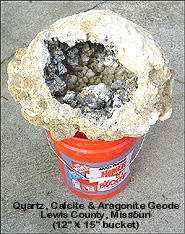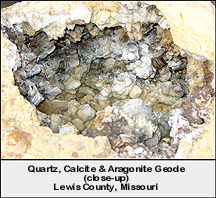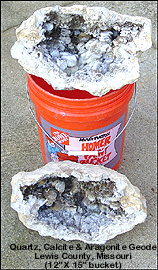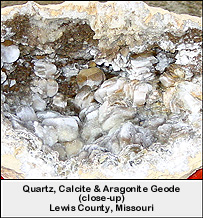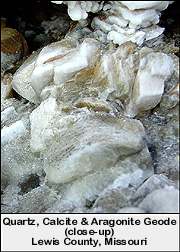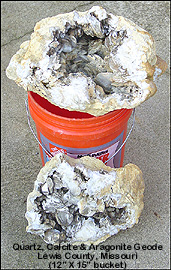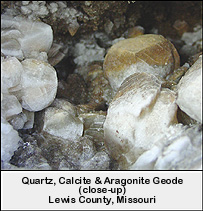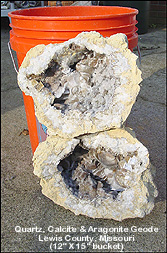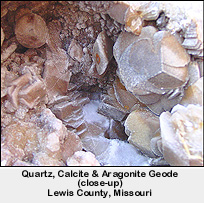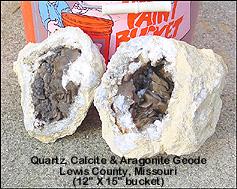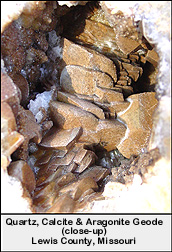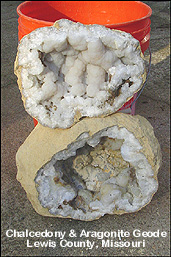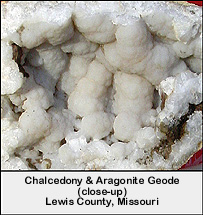A wildly successful day of rockhounding can sometimes happen from simply being in the right place at the right time. Such was the case on a sunny warm spring afternoon in northeast Missouri.
The tri-state area of southeast Iowa, northeast Missouri and western Illinois, is renowned for its geodes. The roundish hollow crystal-filled rocks are collectively referred to as "Keokuk Geodes", having been named after the city of Keokuk, Iowa located in the heart of the collecting area. Most of the geodes are derived from the lower Warsaw Formation, a widespread rock unit of Mississippian age. Calcium carbonate and clay muds deposited in a shallow sea about 340 million years ago were subsequently lithified to form the shales, shaley dolomites, and limestones. Geodes can be dug out of exposures of the lower Warsaw Formation where they are concentrated in certain layers. Loose geodes can also be collected in stream channels where water has eroded the rock.
Geodes from the Keokuk area contain a variety of minerals, but quartz is dominant in most. Beautiful transparent to white quartz crystals cover the interior walls of many geodes. Chalcedony forms the outer shell in all Keokuk geodes. White, gray, blue, yellow or orange chalcedony also encrust the interior walls of many geodes. Calcite is common and occurs in many crystal habits and colors. An additional 17 minerals have been identified in Keokuk geodes; some of the more noteworthy include: kaolinite, dolomite, pyrite and sphalerite.
After spending the morning collecting geodes at the Stevenson Property just outside Hamilton, Illinois, we followed Everett Harrington to a location south of Keokuk where he, Virgil Richards and others had spent a couple days in May 2006 collecting very large geodes (Click Here For Virgil's Report). It was then that they had discovered an area adjacent to a road construction project where geodes up to 2-ft in diameter were contained in a hard limestone. The huge thin-shelled geodes were filled with an assortment of minerals, including quartz, calcite, chalcedony and aragonite. Perhaps most impressive were the ones with large tabular and scalenohedral silver to white colored calcite crystals that were either completely or partially coated with chocolate brown iron oxides with a frosting of sparkling white aragonite.
 However, recovering the geodes intact was problematic for two major reasons: 1)The geodes were almost entirely imbedded in a hard limestone floor so that only the very tops were exposed when the site was graded by heavy equipment. This meant that one would have to break rock perpendicular to the bedding plane essentially carving the geode out of the rock; 2) The thin shelled nature of the geodes made them relatively fragile and therefore more likely to break into pieces during the extraction process. Despite the constraints, many fine geodes were recovered. Everett named the location "Area C-61" and kept the directions to the site between him and the other rockhounds . . . at least until he showed it to us on Sunday, April 1, 2007.
However, recovering the geodes intact was problematic for two major reasons: 1)The geodes were almost entirely imbedded in a hard limestone floor so that only the very tops were exposed when the site was graded by heavy equipment. This meant that one would have to break rock perpendicular to the bedding plane essentially carving the geode out of the rock; 2) The thin shelled nature of the geodes made them relatively fragile and therefore more likely to break into pieces during the extraction process. Despite the constraints, many fine geodes were recovered. Everett named the location "Area C-61" and kept the directions to the site between him and the other rockhounds . . . at least until he showed it to us on Sunday, April 1, 2007.
While Everett, Cori, Cheryl and Mother Celia stopped off to investigate a large pile of rocks adjacent to road construction, Chrissy, Opal and I went about a mile ahead to Area C-61. After receiving much rain in preceding days, the 200 yard inclined access road to the site was very muddy, but passable. After having obsessed about collecting there for the past year, I wasn't going to let a little bit of mud hold us back.
Based on Everett's and Virgil's experience, I was expecting to spend a brutal afternoon busting rock and, at best, hoped to recover at least one of the giant geodes. We got out of the truck and began searching the ground for an area
that fit their description. At first, I was somewhat overwhelmed with the immense size of the cleared area and thought that finding the right spot might be like finding a needle in a haystack, especially since it appeared that fresh grading had taken place and fresh rock was piled up in long rows. I
 continued to look closely at areas with cleared flat limestone and saw some signs of geodes, but none that looked like they were worthy of extraction. Feeling a little frustrated with the lack of promise in the limestone floor, I turned my attention to the fresh rock piles.
continued to look closely at areas with cleared flat limestone and saw some signs of geodes, but none that looked like they were worthy of extraction. Feeling a little frustrated with the lack of promise in the limestone floor, I turned my attention to the fresh rock piles.
"Hey, what's that?", I asked myself, as came upon a large rounded rock about 20-inches across. "Hmmmm . . . was that one of the geodes just laying out on the ground?", I wondered. There was only one way to find out, so I placed my chisel on the side and gave it a mighty whack with my 6-pound sawed off sledge. The chisel found little resistance and the next thing I knew I was staring through a hole into the inside of a geode! With a few more careful blows, I was able to pop the top off to find an interior coated with large poker chip calcites coated with chocolate brown iron oxide and sparkling white aragonite. "Yippee!!!!" I hollered over to Chrissy to show her what I had found and she was equally excited. After that, we concentrated our search on the limestone piles.
Within a very short time, we discovered that there were loose geodes seemingly everywhere. In the mix, we would also find the remains of blasting wire,
indicating that the area had been blasted in addition to being partially
graded. This meant the huge geodes that had been contained in hard limestone were simply laying out ripe for the picking. There were so many of them, we were like kids in a candy store and splitting them open was almost like childs play since the outer shells were so thin. Even little Chrissy was able to break apart 2-ft diameter geodes that were almost too heavy for her to lift. "Yippee times a thousand!!!"
After about an hour, we had accumulated quite a pile of geodes. Just about the
time that I was going to go get Everett and the others so that they could get in on the geode extravaganza, they showed up. Everett was bemused when I ran
over to him and gave him a big bear hug and led him over like an excited adolescent to see our pile of geodes.
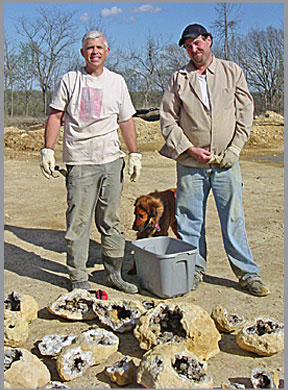
The next several hours were spent by all happily hunting, busting and carrying geodes. To say that we were excited to be there would be an understatement.
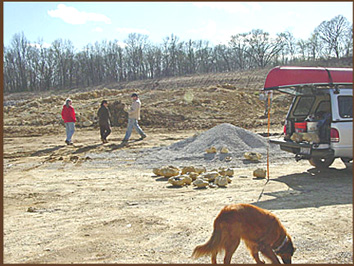
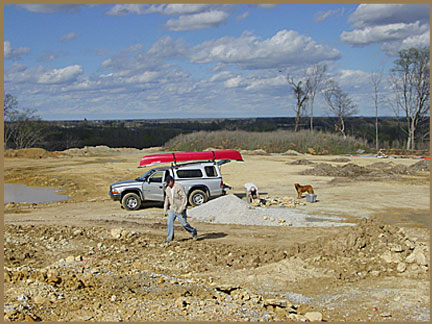
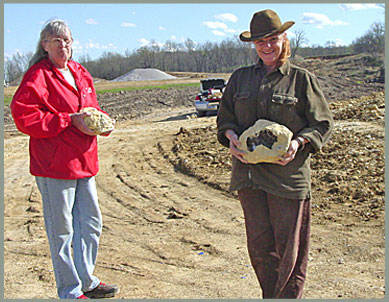
Celia & Cori
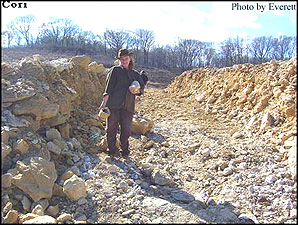
 Chrissy and I collected more geodes that we could fit into our truck, so we gave away about a third of we had found to Cheryl and Cori and left the rest on the ground for some lucky rockhound to find. One of the many geodes left behind was about 2-ft in diameter and full of fantastic minerals. One might think that having to leave such a great specimen would hurt, but considering the big load in the back of our truck, we were only too happy to have someone find it just sitting there on the ground.
Chrissy and I collected more geodes that we could fit into our truck, so we gave away about a third of we had found to Cheryl and Cori and left the rest on the ground for some lucky rockhound to find. One of the many geodes left behind was about 2-ft in diameter and full of fantastic minerals. One might think that having to leave such a great specimen would hurt, but considering the big load in the back of our truck, we were only too happy to have someone find it just sitting there on the ground.
Three pickup trucks and one rental sedan were much lower to the ground as we made our way back down the access road to the highway and then back to Keokuk. Sure enough, we felt lucky to be in the right place at the right time, and this was before what we would learn later that week . . .
We let our success be known to certain other friends, including Virgil Richards, who had spent a great deal of time and effort in May 2006 attempting with moderate success to recover monster geodes from Area C-61. Upon the news, Virgil, who lives near Tulsa, Oklahoma made plans to drive 8 hours to the site on the following Saturday. Virgil, who had just been in the Keokuk area collecting with us the preceding Saturday, had ironically driven right past Area C-61 on his way home. He would have stopped, but he had had been told by a certain individual, who shall remain nameless and is currently in the witness protection program, that site had been reclaimed so that geodes were no longer accessible. "OUCH!!!!!"
On Saturday, April 7, 2007, Virgil and a friend drove all the way from Tulsa
to Area C-61. They were eager and excited to collect their own pile of monster geodes. But, when they got there, they discovered that the entire area had been
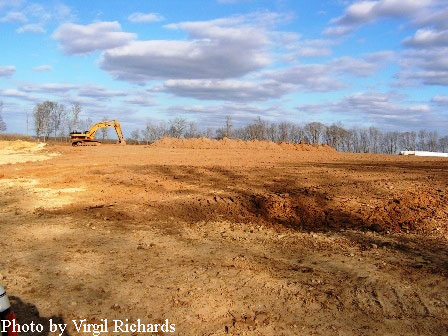 completely reclaimed so that it appeared that the geode-bearing rocks and strata were completely covered over and the area was graded flat. "OUCH times a thousand!!!". The property owner just happened to be there that day and Virgil found out by talking to him that the Missouri Department of Transportation (MDOT) spent the preceding week reclaiming the area that had been previously exploited for road construction rock. According to the owner, the MDOT had blasted the site as part of the reclamation process before covering and grading it. Therefore, there was a very short window of opportunity where geodes could be picked up and our small group had just happened to be there on the 1st before it closed. Yep, lucky us, but poor Virgil who ended up being in the right place at the wrong time.
completely reclaimed so that it appeared that the geode-bearing rocks and strata were completely covered over and the area was graded flat. "OUCH times a thousand!!!". The property owner just happened to be there that day and Virgil found out by talking to him that the Missouri Department of Transportation (MDOT) spent the preceding week reclaiming the area that had been previously exploited for road construction rock. According to the owner, the MDOT had blasted the site as part of the reclamation process before covering and grading it. Therefore, there was a very short window of opportunity where geodes could be picked up and our small group had just happened to be there on the 1st before it closed. Yep, lucky us, but poor Virgil who ended up being in the right place at the wrong time.
The following pictures show some of what we found on our lucky day.
Click on each specimen picture to enlarge
Click on each specimen picture to enlarge
